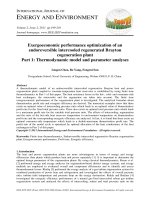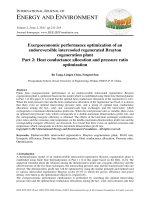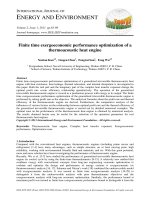Performance Optimization
Bạn đang xem bản rút gọn của tài liệu. Xem và tải ngay bản đầy đủ của tài liệu tại đây (146.32 KB, 25 trang )
83
CHAPTER 4
Performance Optimization
Tuning Ubuntu Server
Like a Racing Car
N
o matter on which kind of server you install it, Ubuntu Server will always be installed
with the same settings. To give an example, the area of reserved memory in RAM for
packets coming in to the network board will always be the same, no matter if your server
has 128 MB or 128 GB of RAM. As you can guess, there’s something to gain here! In this
chapter you’ll read about performance optimization. We’ll explore what possibilities
there are to optimize performance of the CPU, RAM, storage, and network. I’ll also give
a few hints on optimizing performance for network services like Samba and NFS. If every-
thing goes well, at the end of this chapter, your server will be performing a lot better.
Strategies for Optimizing Performance
You can look at performance optimization in two different ways. For some people, it
just means changing some parameters and seeing what happens. That is not the best
approach. A much better approach is to start with performance monitoring first. This
will give you some crystal- clear ideas about what exactly is happening with performance
on your server. Before optimizing anything, you should know what exactly to optimize.
For example, if the network performs badly, you should know whether the problems are
caused by the network or caused by an insufficient amount of memory allocated for the
network packets coming in and going out. So make sure you know what to optimize.
About /proc and sysctl
Once you know what to optimize, it comes down to actually doing it. In many situa-
tions, optimizing performance means writing a parameter to the
+lnk_
file system. This
CHAPTER 4
N
PERFORMANCE OPTIMIZATION
84
file system is created by the kernel when your server boots up, and normally contains
the settings that your kernel is working with. Under
+lnk_+ouo
, you’ll find many system
parameters that can be changed. The easy way to change system parameters is to
a_dk
the
new value to the configuration file. For example, the
+lnk_+ouo+ri+os]llejaoo
file contains
a value that indicates how willing your server is to swap. The range of this value is 0 to
100; a low value means that your server will avoid swapping as long as possible, whereas
a high value means that your server is more willing to swap. The default value in this file
is 60. If you think your server is too eager to swap, you could change this value, using
a_dk/,:+lnk_+ouo+ri+os]llejaoo
This method works well, but there is a problem. As soon as your server restarts, you
will lose this value. So, the better solution is to store it in a configuration file and make
sure that configuration file is read when your server boots up again. A configuration file
exists for this purpose, named
+ap_+ouo_ph*_kjb
. When booting, your server starts the
lnk_lo
service that reads this configuration file and applies all settings in it. So, to make it
easier for you to apply the same settings again and again, put them in this configuration
file. There is a small syntax difference, though.
In
+ap_+ouo_ph*_kjb
, you refer to files that exist in the
+lnk_+ouo
hierarchy. So the
name of the file you are referring to is relative to this directory. Also, instead of using
a slash as the separator between directory, subdirectories, and files, it is common to use
a dot (even if the slash is accepted as well). That means that to apply the change to the
os]llejaoo
parameter previously introduced, you would include the following line in
+ap_+ouo_ph*_kjb
:
ri*os]llejaoo9/,
This setting would be applied only the next time that your server reboots. Instead of
just writing it to the configuration file, you can apply it to the current
ouo_ph
settings as
well. To do that, use the
ouo_ph
command; the following command can be used to apply
this setting immediately:
ouo_phri*os]llejaoo9/,
In fact, using this solution does exactly the same thing as using the
a_dk/,:
+lnk_+ouo+ri+os]llejaoo
command. The most practical way of applying these settings
is to write them to
+ap_+ouo_ph*_kjb
first, and then activate them using
ouo_ph)l+ap_+
ouo_ph*_kjb
. Once the settings are activated in this way, you can also get an overview of all
current
ouo_ph
settings, using
ouo_ph)]
. Listing 4-1 shows a partial example of the output
of this command.
CHAPTER 4
N
PERFORMANCE OPTIMIZATION
85
Listing 4-1. sysctl -a Shows All Current sysctl Settings
bo*ejk`a)jn9--553/,,
bo*ejk`a)op]pa9--553/,,,,,,,
bo*beha)jn94/.,/21/-/
bo*beha)i]t9/21/-/
bo*`ajpnu)op]pa9-/0,241-501,,,
bo*kranbhksqe`9211/0
bo*kranbhksce`9211/0
bo*ha]oao)aj]^ha9-
bo*`en)jkpebu)aj]^ha9-
bo*ha]oa)^na]g)peia901
bo*]ek)jn9,
bo*]ek)i]t)jn9211/2
bo*ejkpebu*i]t[qoan[ejop]j_ao9-.4
bo*ejkpebu*i]t[qoan[s]p_dao91.0.44
bo*ejkpebu*i]t[mqaqa`[arajpo9-2/40
***
oqjnl_*q`l[ohkp[p]^ha[ajpneao9-2
oqjnl_*p_l[ohkp[p]^ha[ajpneao9-2
oqjnl_*iej[naorlknp9221
oqjnl_*i]t[naorlknp9-,./
The output of
ouo_ph)]
can be somewhat overwhelming. I recommend using it in
combination with
cnal
to find the information you need. For example,
ouo_ph)]xcnal
tbo
would show you only lines that have the text
tbo
in their output.
Applying a Simple Test
Although
ouo_ph
and its configuration file
ouo_ph*_kjb
are very useful tools to change
performance- related settings, you should thoroughly test your changes before applying
them. Before you write a parameter to the system, make sure that it really is the param-
eter you need. The big question, though, is how to know that for sure. Even if not valid
in all cases, I like to do a small test with a 1 GB file to find out what exactly the effect of
a parameter is. First, I create a 1 GB file, using the following:
``eb9+`ar+vankkb9+nkkp+-C>beha^o9-I_kqjp9-,.0
By copying this file around and measuring the time it takes to copy it, you can get
a pretty good idea of the effect of some of the parameters. Many tasks you perform
on your Linux server are I/O- related, so this simple test can give you an impression of
CHAPTER 4
N
PERFORMANCE OPTIMIZATION
86
whether or not there is any improvement after you have tuned performance. To measure
the time it takes to copy this file, use the
peia
command, followed by
_l
, as in
peia_l
+nkkp+-C>beha+pil
. In Listing 4-2, you can see an example of what this looks like when
measuring I/O performance on your server. In this example, I’m using the
peia
command
to measure how much time it took to complete a given command. The output of
peia
gives three parameters:
s
na]h
: The real time, in seconds, it took to complete the command. This includes
waiting time as well.
s
qoan
: The time spent in user space that was required to complete the command.
s
ouo
: The time spent in system space to complete the command.
Listing 4-2. Use time to Measure Performance While Copying a File
nkkp<iah6z``eb9+`ar+vankkb9+nkkp+-C>beha^o9-I_kqjp9-,.0
-,.0',na_kn`oej
-,.0',na_kn`okqp
-,3/30-4.0^upao$-*-C>%_klea`(3*31545o(-/4I>+o
nkkp<iah6zpeia_l-C>beha+pil
na]h,i4*200o
qoan,i,*,1,o
ouo,i.*51,o
When doing a test like this, though, it is important to interpret it in the right way.
Consider for example Listing 4-3, in which the same command was repeated a few sec-
onds later.
Listing 4-3. The Same Test, 10 Seconds Later
nkkp<iah6zpeia_l-C>beha+pil
na]h,i3*554o
qoan,i,*,2,o
ouo,i/*./,o
As you can see, it now performs about two- thirds of a second faster than the first time
the command was used. Is this the result of a performance parameter that I’ve changed in
between? No, but let’s have a look at the result of
bnaa)i
, as shown in Listing 4-4.
CHAPTER 4
N
PERFORMANCE OPTIMIZATION
87
Listing 4-4. Cache Also Plays an Important Role in Performance
nkkp<iah6zbnaa)i
pkp]hqoa`bnaaod]na`^qbbano_]_da`
Iai6/543..02-30-,-3.-,4
)+'^qbbano+_]_da6--5/423
Os]l6.,03,.,03
Any idea what has happened here? The entire 1 GB file was put in cache. As you can
see,
bnaa)i
shows almost 2 GB of data in cache that wasn’t there before and that has an
influence on the time it takes to copy a large file around.
So what lesson is there to learn? Performance optimization is complex. You have to
take into account multiple factors that all have their influence on the performance of
your server. Only when this is done the right way will you truly see how your server per-
forms and whether or not you have succeeded in improving its performance. If you’re not
looking at the data properly, you may miss things and think that you have improved per-
formance, while in reality you might have made it worse.
N
Caution
Performance tuning is complicated. If you miss a piece of information, the performance penalty
for your server may be severe. Only apply the knowledge from this chapter if you feel confident about your
assumptions. If you don’t feel confident, don’t change anything, but instead ask an expert for his opinion.
CPU Tuning
Assuming that you have applied all the lessons from Chapter 3 and have a clear picture
of what is wrong with the utilization of your server, it is time to start optimizing. In this
section you’ll learn what you can do to optimize the performance of your server’s CPU.
First, you’ll learn about aspects of the inner workings of the CPU that are important when
trying to optimize performance parameters for the CPU. Then, you’ll read about several
common techniques to optimize CPU utilization.
Understanding CPU Performance
To be able to tune the CPU, you should know what is important with regard to this part of
your system. To understand CPU performance, you should know about the thread sched-
uler. This part of the kernel makes sure that all process threads get an equal number of
CPU cycles. Because most processes will do some I/O as well, it’s not a problem that the
scheduler puts process threads on hold momentarily. While not being served by the CPU,
CHAPTER 4
N
PERFORMANCE OPTIMIZATION
88
the process thread can wait for I/O. The fact that the process is doing that while being put
on hold by the scheduler increases its efficiency. The scheduler operates by using fair-
ness, meaning that all threads are moving forward using equal time segments. By using
fairness, the scheduler makes sure there is not too much latency.
The scheduling process is pretty simple in a single- CPU core environment. Naturally,
it is more complicated in a multicore environment. To work in a multi- CPU or multicore
environment, your server uses a specialized symmetric multiprocessing (SMP) kernel.
If needed, this kernel is installed automatically. In an SMP environment, the scheduler
should make sure that some kind of load balancing is used. This means that process
threads are spread over all available CPU cores. In fact, if a program is not written using
a multithreaded or multiprocessor architecture, the kernel could only run this mono-
lithic program on a dedicated CPU core. The kernel is only able to dispatch threads or
processes on CPU cores, so only multithreaded processes could have their execution flow
dispatched on distinct CPU cores. For example, if the Apache Web Server is compiled
using the legacy mono- process architecture, it will take one CPU core. If it is compiled
with the multiprocessor or multithreaded model, all processes and threads will run at the
same time on the different CPU threads.
A specific concern in a multi- CPU environment is to ensure that the scheduler pre-
vents processes and threads from being moved to other CPU cores. Moving a process
means that the information the process has written in the CPU cache has to be moved as
well, and that is a relatively expensive procedure.
You may think that a server will benefit if you install multiple CPU cores, but this is
not true. When working on multiple cores, chances increase that processes swap around
between cores, taking their cached information with them, which slows down perfor-
mance in a multiprocessing environment. In two specific situations, you can benefit from
a multiprocessing environment:
s 7HENUSINGVIRTUALIZATIONYOUCANPINVIRTUALMACHINESTOAPARTICULAR#05CORE
s 7HENUSINGANAPPLICATIONTHATISWRITTENFORAN3-0ENVIRONMENTFOREXAMPLE
Oracle), the kernel will be able to dispatch all the threads and processes on the dif-
ferent cores efficiently.
Optimizing CPU Performance
CPU performance optimization is really just about doing two things: prioritizing pro-
cesses and optimizing the SMP environment. Every process gets a static priority from the
scheduler. The scheduler can differentiate between real- time (RT) processes and normal
processes, but if a process falls into one of these categories, it will be equal to all other
processes in the same category. That means the priority of RT processes is higher than the
CHAPTER 4
N
PERFORMANCE OPTIMIZATION
89
priority of normal processes, but also that it is not possible to differentiate between differ-
ent RT processes. Be aware, though, that some RT processes (most of them are part of the
Linux kernel) will run with highest priority, whereas the rest of the available CPU cycles
have to be divided between the other processes. In that procedure, it’s all about fairness:
the longer a process is waiting, the higher its priority will be.
The way that the scheduler does its work is not tunable by any parameter in the
+lnk_
file system. The only way to tune it is by changing the values for some parameters that are
defined in the kernel source file
ganjah+o_da`*_
. Because this is a difficult procedure that
in most situations doesn’t give any benefits, I strongly advise against it. Another reason
why you shouldn’t do it is that, in modern Linux systems, there is another, much more
efficient method to do this: use the
je_a
command.
Adjusting Process Priority Using nice
You probably already know how the
je_a
command works. It has a range that goes from
-20 to 19. The lower the
je_a
value of a process, the higher its priority. So a process that
has a
je_a
value of -20 will always get the highest possible priority. I strongly advice
against using -20, because if the process that runs with this
je_a
value is a very busy pro-
cess, you risk other processes not being served at all anymore. This could even result in
a crash of your server, so be careful with -20. If ever you want to adjust the
je_a
value of
a process, do it by using increments of 5. So if you want to increase the priority of the pro-
cess using PID 1234, try using
naje_a
, as follows:
naje_a)1-./0
See if the process performs better now, and if it doesn’t,
naje_a
it to -10, but never go
beyond the value of -15, because you risk making your server completely dysfunctional.
If ever you feel the need to increase process priority of a process beyond -15, your server
probably just is overloaded and there are other measures to take. In that case, you may
benefit from one of the following options:
s #HECKWHICHPROCESSESARESTARTEDWHENYOUBOOTYOURSERVER9OUCANUSETHE
ouor_kjbec
utility to display a list of all services and their current startup status.
You may have some processes that you don’t really need. Remove them from your
runlevels.
s 3EEIFPROCESSESARECOMPETINGFOR#05CYCLES9OUCANDOTHISBYLOOKINGATTHE
output of
pkl
. If you see several processes that are very busy, they definitely are
competing for CPU cycles. If this is the case, try offloading one or more processes
to another server.
CHAPTER 4
N
PERFORMANCE OPTIMIZATION
90
s ,OOKATTHEWAITTIMEFORYOUR#05)FTHEWAITTIMEASSHOWNBYTHE
s]
param-
eter in
pkl
, is high, the problem might not be process related, but rather storage
related.
s )FITISMAINLYONEPROCESSTHATISVERYBUSYTHUSPREVENTINGOTHERPROCESSESFROM
doing their work, see if you can run it on a multicore server. In that scenario, the
busy process can just claim one of the cores completely (given that it is developed
using the multiprocessing model), while all vital system processes are served by
the other core.
Optimizing SMP Environments
If you are working in an SMP environment, one important utility to use to improve per-
formance is the
p]ogoap
command. You can use
p]ogoap
to set CPU affinity for a process
to one or more CPUs. The result is that your process is less likely to be moved to another
CPU. The
p]ogoap
command uses a hexadecimal bitmask to specify which CPU to use. In
this bitmap, the value
,t-
refers to CPU0,
,t.
refers to CPU1,
,t0
refers to CPU2,
,t4
refers
to CPU3, and so on.
N
Note
I follow the default Linux way of referring to CPU numbers, in which CPU0 is the first CPU, CPU1 the
second, and so on.
So if you have a command that you would like to bind to CPUs 2 and 3, you would
use the following command:
p]ogoap,t?okia_kii]j`
N
Note
If you are surprised about the
,t?
in the preceding command, the number used by
p]ogoap
is
a hexadecimal number. CPUs 2 (hexadecimal value 4) and 3 (hexadecimal value 8) make up the value of 12,
which, when written in a hexadecimal way, equals C.
You can also use
p]ogoap
on running processes, by using the
)l
option. With this
option, you can refer to the PID of a process; for instance,
p]ogoap,t/3,/0
would set the affinity of the process using PID 7034 to CPUs 0 and 1.
CHAPTER 4
N
PERFORMANCE OPTIMIZATION
91
You can specify CPU affinity for IRQs as well. To do this, you can use the same bit-
mask that you use with
p]ogoap
. Every interrupt has a subdirectory in
+lnk_+enm+
, and in
that subdirectory there is a file with the name
oil[]bbejepu
. So, for example, if your IRQ
5 is producing a very high workload (check
+lnk_+ejpannqlpo
to see if this is the case) and
you therefore want that IRQ to work on CPU1, use the following command:
a_dk,t.:+lnk_+enm+/+oil[]bbejepu
Tuning Memory
System memory is a very important part of a computer. It functions as a buffer between
CPU and I/O. By tuning memory, you can really get the best out of it. Linux works with
the concept of virtual memory, which is the total of all usable memory available on
a server. You can tune the working of virtual memory by writing to the
+lnk_+ouo+ri
directory. This directory contains lots of parameters that help you to tune the way your
server’s memory is used. As always when tuning the performance of a server, there are no
solutions that work in all cases. Use the parameters in
+lnk_+ouo+ri
with caution and use
them one by one. Only by tuning each parameter individually will you be able to deter-
mine whether you really got better memory performance.
Understanding Memory Performance
In a Linux system, virtual memory is used for many purposes. First, there are processes
that claim their amount of memory. When tuning memory consumption for processes,
it helps to know how these processes allocate memory. For instance, a database server
that allocates large amounts of system memory when starting up has different needs
from those of a mail server that works with small files only. Also, each process has its own
memory space, which may not be addressed by other processes. The kernel ensures that
this never happens.
When a process is created, using the
bkng$%
system call (which basically creates
a child process from the parent), the kernel creates a virtual address space for the process.
The virtual address space used by a process is made up of pages. These pages have a fixed
size of 4 KB on a 32- bit system. On a 64- bit server, you can choose between 4, 8, 16, 32,
and 64 KB pages.
Another important aspect of memory usage is caching. Your system includes a read
cache and a write cache, and the way in which you tune a server that handles mostly read
requests differs from the way in which you tune a server that handles write requests.
CHAPTER 4
N
PERFORMANCE OPTIMIZATION
92
Optimizing Memory Usage
Basically, there are two kinds of servers: servers that run a heavy application that allocates
lots of memory, and servers that offer services and therefore are accessed frequently by
users. Depending on the kind of server you use, you can follow a different optimization
approach. Three items are of specific interest with regard to this issue: the configuration
of huge pages, the optimization of the write cache, and the optimization of inter- process
communication.
Configuring Huge Pages
If your server is a heavily used application server, it may benefit from using large
pages, also referred to as huge pages. A huge page by default is 2 MB. Using huge pages
may be useful to improve performance in high- performance computing and with
memory- intensive applications. By default, no huge pages are allocated, because they
would be a waste on a server that doesn’t need them. Typically, you set them from the
Grub boot loader when you’re starting your server. Later on, you can check the number
of huge pages in use from the
+lnk_+ouo+ri+jn[dqcal]cao
parameter. The following proce-
dure summarizes how to set huge pages:
1. Using an editor, open the Grub menu configuration file in
+^kkp+cnq^+iajq*hop
.
2. Find the part of the configuration file that defines how your system should boot.
It looks like the example in Listing 4-5.
Listing 4-5. The Boot Section in /boot/grub/menu.lst
pephaQ^qjpq4*,0(ganjah.*2*.0)-2)oanran
nkkp$d`,(,%
ganjah+rihejqv).*2*.0)-2)oanrannkkp9+`ar+i]llan+ouopai)nkkp
±
nkmqeapolh]odXdqcal]cao920
ejepn`+ejepn`*eic).*2*.0)-2)oanran
mqeap
3. In the
ganjah
line, make sure that you enable huge pages, by using the parameter
dqcal]cao9jj
. In Listing 4-5, I have defined the number of huge pages for this
server to be 64.
4. Save your settings and reboot your server to activate them.
Be careful, though, when allocating huge pages. All memory pages that are allocated
as huge pages are no longer available for other purposes, and if your server needs a heavy
read or write cache, you will suffer from allocating too many huge pages immediately. If









